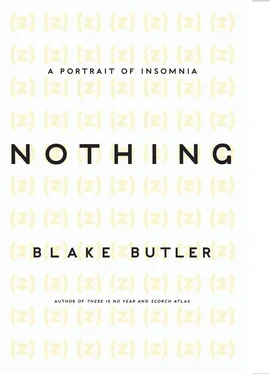In the ’80s, we get CDs, flash memory, the artificial heart, hair metal, digital audio tape, the internet. A record number of people tune in to the soap opera Dallas , caught up in a conspiracy of who shot the central character — the programmed death of such manifestations, as well as who is fucking who in pretend on screen, will continue to be primary reasons for tuning in to anything for a lot of people. “The succession of the seasons and the superposition of the same season from different years dissolves forms and persons and gives rise to movements, speeds, delays, and affects,” write Deleuze and Guattari, “as if as the narrative progressed something were escaping from an impalpable matter.”126
In 1981, the sleep drug trazodone is approved by the FDA. It will come to be known by many other names, like a god: it will be Beneficat, Deprax, Desirel, Desyrel, Molipaxin, Thombran, Trazorel, Trialodine, Trittico. During the next thirty or so years, the presence of these pills will replicate in name and manner of effect, including: zolpidem (increases sleep time, and in some cases has been found to revive patients from a minimally conscious coma to a fully conscious state), zaleplon (reduces awakening), estazolam (maintains duration and quality of sleep), flurazepam (helps sleep induction), quazepam (to be avoided in elderly patients), temazepam (decreases awakenings but distorts normal sleep pattern), and triazolam (known to cause adverse effects on memory). Each of these agents as well, like trazodone, enjoys a sublist of other equally mythologically dreamlike names by which they are marketed to users: zolpidem is Adormix, Ambien, Ambien CR, Edluar, Damixan, Hypnogen, Ivedal, Lioran, Myslee, Nytamel, Sanval, Stilnoct, Stilnox, Stilnox CR, Sucedal, Zoldem, Zolnod, and Zolpihexal; zaleplon is Sonata and Starnoc; estazolam is Eurodin, ProSom; flurazepam is Dalmadorm and Dalmane; quazepam is Doral, Dormalin; temazepam is Euhypnos, Norkotral, Normison, Remestan, Restoril (found in the blood of Heath Ledger on his deathbed, along with the OTC pill Unisom), Temtabs, and Tenox; triazolam is Apo-Triazo, Halcion (Jeffrey Dahmer’s brand of choice for sedating victims), Hypam, and Trilam. Each pill as well might have many names saved for the street: “terms for temazepam include King Kong pills, jellies, jelly, Edinburgh eccies, tams, terms, mazzies, temazies, tammies, temmies, beans, eggs, green eggs, wobbly eggs, knockouts, hardball, norries, oranges, rugby balls, ruggers, terminators, red and blue, no-gos, blackout, green devils, drunk pills, brainwash, mind-erasers, tem-tems, mommy’s big helper, vitamin T, big T, TZ, and others.”127 This for each goes on and on, language bifurcating around the object. In each word lurk several dozen; from each pill spring more pills to observe, and more pills manufactured in competition, begging which is best to suit your head.
In 1987, we get the Sleep Number bed, allowing the consumer to choose a setting between 0 and 100, as fits one’s comfort; eventually, consumers will issue complaints about how the air pockets in the Sleep Number mattresses grow mold. Sleep deprivation procedures are used by David Koresh in his Branch Davidian compound, and later, from the other end, by the CIA against the compound from the outside in an attempt to force its inhabitants to surrender. Each year computers keep getting smaller, smarter. They are taught to talk in human speech. Meanwhile TVs grow in the reverse direction, though also aimed at more correctly replicating the things we see, sized as we are, or even larger. Our atmospheric volume stays the same. Rats in labs are subjected to sleep deprivation and grow lesions and bacterial colonies in their flesh, losing weight despite increased eating; later the rats die. The most common sleep position is found to be fetal. How one sleeps is said to reflect one’s personality, mirror one’s fate. Every minute there are more ideas, theories, and classification systems of the intricacies of waking and of sleeping, and therefore of sleep trouble, polysomnias, meta-thoughts, than ever. Photographs of night continue to exist during the day.
The cities sprawl. In 1989, the Guinness record for world’s longest movie is an eighty-five-hour-long creation titled The Cure for Insomnia , which consists almost entirely of a guy reading his 4,080-page poem of the same name, occasionally cut with heavy metal and clips from porn. The next year, Adobe Photoshop 1.0 is released into the public, popularizing direct manipulation of the image. In 1992, we get memory foam , which learns to mold itself around our bodies. “I am tired” becomes so common a phrase it’s no longer even worth admitting.
In 1995, the direct cost of insomnia in the U.S. for medications and health care services is estimated at $13.96 billion.128 That same year the fourteen members of the Order of the Solar Temple doomsday group are found dead in a forest in the French Alps, arranged in a star formation, most with sleep drugs in their blood. A year earlier, another forty-eight of the same group had been found dead, many in a mirror-lined underground chapel, arranged into a circle and full of sleep drugs, with plastic bags around their heads to protect against the plague they believed was coming for all humans at their exit. Deleuze throws himself out of a window.
By the end of the twentieth century, reports say sleep time in Americans over the past hundred years has decreased by 20 percent. Reports show that the errors caused by our lost sleep result in more than 110,000 injuries and 5,000 fatalities every year, not to mention incidents such as Chernobyl, the Challenger , the Exxon Valdez —the damage leaking out into air and water, back into our blood. Sleep loss is shown to cause obesity, diabetes, cardiovascular disease, anxiety, depression, and alcoholism. The queen-sized mattress at last passes the twin as the most popular American size of bed. Lack of sleep will soon be linked to weight gain. We map the human genome.
Days continue to act within the length of days. We get Google, YouTube, Myspace, Facebook. On each of these sites, and many like them, new data is added by the second by the bit, with multibillion users awake and online at any time. Pictures of people’s heads appear on further websites, aggregated. We have all these passwords to remember, and questions to answer to retrieve the passwords, and codes written to try to trick the passwords from our heads. Spam mail accrues in folders often unaccounted, relaying sentences such as “I went to sleep, woke up, and there was more money in my account.” We get breath strips and Bluetooth, satellite radio, the artificial liver. People are diagnosed as having sleep sex and sleep e-mailing in the manner of somnambulism. We get human-approved Botox, which 150 years prior had been known as sausage poison. The largest shopping mall ever on the earth opens in China and remains perpetually 99 percent unfilled. Fewer people need to walk or speak more often because there are machines that do it for them. People laugh, still. There are parties. Certain men announce themselves as god returned in human form and they are killed or kill themselves. Kids are also killing other kids in schools more often, and eating pills more often. We get the birth control patch, the Date Rape Drug Spotter, GPS. We get the iPod and its competing replicants, each version smaller than the one before. Bodies make more bodies and those bodies make more too — the method of the making, at least, doesn’t change in how it works upon the body, though the body is no longer officially required. People continue to write their own sentences and record music and say words and take more photographs and they consume and they emit. Artificial flesh is developed to replace destroyed limbs or regulate the systems in specific hearts or heads. Electronic pets popularize among the young, though the electronic pets can still die. Tanning beds are deemed “as deadly as arsenic and mustard gas” and still are popular as ever.129 There is such sound, so much that when it’s silent some feel the most fear. There are more books than ever, more albums, movies, more ideas, coming from more bodies and machines within further and further subdivided air. All of this information, every hour, goes on in light or no light, while in automated buildings we sleep the same way when we can, eyes alive inside the head and body held still, if interrupted or on pills, waking mornings with the taste of nowhere in our mouths and crust around our eyes. We rise and find our shapes imprinted on the bed’s make and the mattresses conforming over years, filling with living cells of those in feed, and the surrounding walls made slightly thicker with cosmetic paint and a kind of psychic crowd — each room a room where someone else might once have lived once or inside the night come in, packed with an air that goes on before and after anybody, at any instant with and without where, unto whatever.
Читать дальше












